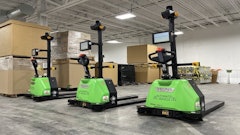
According to the data produced by DispatchTrack, there was a mixed business outlook this year, with 39% expecting business to be down, 29% expecting business to be better than it was last year, and 17% unsure of which way it would go.
Nevertheless, a majority (86%) of supply chain professionals expect fuel and other operating costs to increase for another year in a row, and consistent with last year’s findings, four in 10 plan to pass those added expenses along to their customers by raising fees.
“There’s no question supply chain organizations are feeling the squeeze. Not only are they facing immense economic pressure, but they know they have to get the delivery experience right if they want to retain customers. A big part of that is ensuring deliveries are consistently made on time, so I’m not surprised to see missing delivery windows flagged as a major concern,” says Satish Natarajan, DispatchTrack co-founder and CEO. “CEOs and boards are becoming more actively involved in planning and delivery strategy and championing new systems and tech investments to not only improve operational cost efficiencies but also preserve and grow customer loyalty which are both critical to the bottom line.”
Key takeaways:
- Fuel ranked as the top challenge again this year among nearly half of respondents (49%) though down significantly from 82% last year. Losing business due to the economy jumped to 43% this year from 38% last year followed by delays outside of their control, which rose to 40% from 37% in 2022. Threats of extreme weather conditions jumped higher up the list of major concerns to 36% in 2023, up from just 14% last year.
- Missing delivery windows was once again a primary concern among those surveyed while inventory shortages and oversupply challenges appear to have eased. To improve operational efficiencies, nearly half of respondents (45%) stated that they have invested in new technology or expanded their existing technologies.
- 39% of organizations expect less business this year while 29% expect more business. A further 17% are uncertain. When it comes to holiday revenue, 35% expect a decrease this year compared to last year while 30% expect an increase. 24% are uncertain.
- Despite fuel costs, 81% of businesses anticipate higher operating costs in the coming year. 6 in 10 expect to see a 10-20% increase while 18% expect to see a 25-50% increase.
- The vast majority (86%) expect operating costs to be even higher in the coming year. Four in 10 expect a 10-20% increase while 37% expect a 25-50% increase.
- Consistent with last year when 41% planned to increase fees, 39% plan to increase fees again this year. A quarter stated they’re increasing fees due to both inflation and fuel, 12% are increasing fees due to inflation and cost increases, and 2% due solely to fuel costs. 37% stated they don’t plan to increase fees this year and a further quarter stated they aren’t planning further increases because they increased fees last year.
- Four in 10 are just as concerned about missing delivery windows this year as last year, while 14% are more concerned.
- Nearly half (48%) are not concerned with inventory shortages or oversupply this year. 22% are concerned with inventory shortages this year while 11% are concerned with oversupply. 19% are concerned with both inventory shortages and oversupply.
- One in two indicate it’s more difficult to recruit and retain drivers this year than last year.
- 19% anticipate more returns this holiday season than in past years.
- Fuel costs remained the top concern this holiday season with nearly half (49%) ranking it as their top concern (down from 82% in 2022). This is followed by losing business due to the economy (43%, up from 38% in 2022), delays outside of their control (40%, up from 37% in 2022), extreme weather (36%, up from 14% in 2022), inflation (31%, down from 50% in 2022), and driver shortages (34%, down from 48% in 2022).
- 23% planned for the holidays earlier this year than last. 67% planned at the same time this year as last year.
- 45% have invested in new technology or expanded their existing technology to increase efficiencies this year.
- 26% of businesses plan to either rent trucks and/or warehouse space to prevent fulfillment roadblocks, down from 41% in 2022. 11% plan to rent warehouse space, 7% plan to rent trucks, and 8% plan to rent both trucks and warehouse space.
- 55% are prioritizing sustainability or plan to in the coming year, a decrease from 70% in 2022. 18% are already prioritizing it while 37% plan to prioritize it. 7% stated that they have either added EV trucks or plan to in the next year, down from 15% in 2022.

















![Pros To Know 2026 [color]](https://img.sdcexec.com/mindful/acbm/workspaces/default/uploads/2025/08/prostoknow-2026-color.mduFvhpgMk.png?ar=16%3A9&auto=format%2Ccompress&bg=fff&fill-color=fff&fit=fill&h=135&q=70&w=240)


